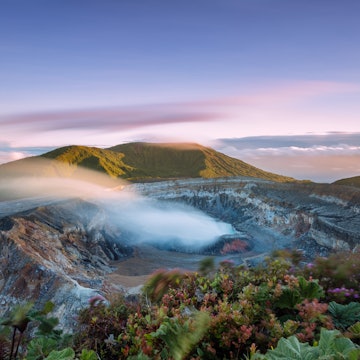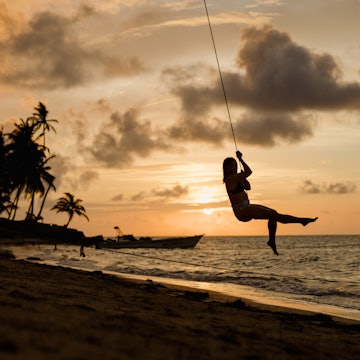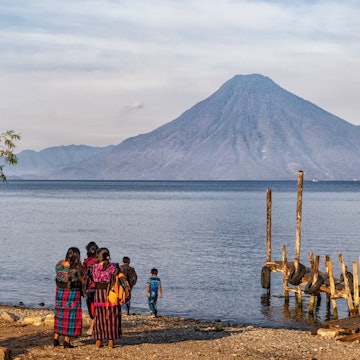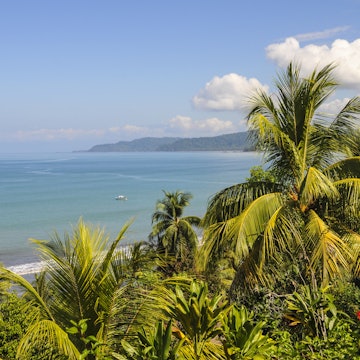

Costa Rica has many beautiful places to visit, and these are eight of our favorites.
With a rich and varied culture and the kind of natural landscape that leaves visitors in awe, Costa Rica is rightfully top of many travelers' must-visit lists.
Adventure lovers in search of adrenaline-pumping experiences? Get your fix hiking through steamy rainforests to still-smoking volcanoes. Tired of the rat race and need to lie down in beautiful places? Take your pick from one of the many sublime beaches scattered along the Pacific and Caribbean coastlines like jewels.
The country’s motto is pura vida – pure life – and a quarter of its landmass is protected by national parks and reserves that offer a wealth of wildlife watching among untamed nature. Where to even start with such riches? Don't stress, we've done the hard work for you. These are the eight best places to visit in Costa Rica.

1. La Fortuna
Best place for outdoor adventures
Volcán Arenal’s picture-perfect cone looms over the town of La Fortuna. Up until 2010, it thrilled visitors with plumes of smoke and lava pyrotechnics, but today climbing to the summit is illegal.
You can still get up close to its lava-covered lower slopes by taking the Las Coladas trail, one of several unforgettable hikes around Volcán Arenal National Park, about 7km (10.5 miles) west of La Fortuna.
Hike down to the impressive waterfall, which plunges out of thick vegetation into an emerald-green pool, or get muddy on a spelunking tour through the limestone labyrinth of the Venado Caves.
Near Volcán Arenal National Park there’s horseback riding, mountain biking, rappelling, and ziplining on offer, along with kayaking and windsurfing on Lake Arenal. The region’s natural hot springs also make it the perfect place to ease weary muscles after all those adventures.

2. Osa Peninsula
Best place for getting off the beaten path
The wild and remote Osa Peninsula is all rainforests, rivers, and mangroves, ringed by pristine beaches.
Wake to a chorus of chirrups, whoops, caws, and the sonorous roar of howler monkeys. Watch spider monkeys put on an impressive display of treetop gymnastics while scarlet macaws squawk and preen. It’s just a typical morning in the Parque Nacional Corcovado, one of the most biodiverse places on the planet.
The gin-clear waters of Bahía Drake are home to humpback whales and dolphins, and it’s the jumping-off point for diving and snorkeling tours to the marine playground of Isla del Caño.
Planning tip: The whale season generally runs between December and April and July and October.
3. Monteverde
Best place for birds, butterflies, and cloud forest canopy tours
Away from Costa Rica’s sun-soaked beaches and steamy rainforests, Monteverde’s mist-wreathed cloud forest reserves sit high on the country’s mountainous spine. It’s one of the world’s biodiversity hot spots, with a staggering array of flora and fauna.
At Curi-Cancha – a cattle ranch turned private reserve – trails wind through primary, secondary, and open forests buzzing with jewel-colored hummingbirds and rowdy toucans. Look out for the aptly named resplendent quetzal with its brilliant green and crimson plumage and sweeping tail feathers – they’re easier to spot during the mating season from March to June.
For a bird’s eye view of the forest, take an adrenaline-fueled ride on a zipline, skimming the canopy at high speed – Sky Trek Monteverde has an automatic braking system, useful for kids and anxious adults.
Planning tip: Take a guided night walk to discover a different side to the forest, when nocturnal critters such as sloths, snakes, and kinkajous get active to a soundtrack of the frog chorus.

4. The Nicoya Peninsula
Best place for sand and surf
Famed for its postcard-perfect beaches and sweet Pacific swells, Nicoya has something for wave riders of all levels.
There’s wildlife too: just north of the party town of Tamarindo, Grande Beach – part of Las Baulas National Marine Park – is a nesting site for leatherback turtles from October to March.
Among the peninsula’s finest strips of sand are the blissfully secluded Playa Barrigona and Sámara, popular with both Ticos and visitors thanks to its calm, safe waters that are ideal for novice surfers. Further south, the remote, jungle-backed town of Santa Teresa – long a haunt of surfers in the know – is now a hip hangout with cool cafes, sushi restaurants, and designer boutiques.
Like an advert for living the pura vida, Nicoya has been named one of the world’s five Blue Zones, where residents have longer-than-average lifespans thanks to their healthy habits and stunning surroundings.
Planning tip: Nicoya’s surf season runs from December to April; most surf schools are closed during the rainy season, from August to November.
5. The Caribbean Coast
Best place for turtle spotting
On Costa Rica’s Caribbean Coast, the flooded forest of Parque Nacional Tortuguero has been dubbed a mini Amazon. It’s home to 400 bird species and from July to October, it's a sanctuary for nesting green sea turtles. Look out for manatees, caiman, and crocodiles as you tour its skinny waterways by boat or kayak.
To the south is the diminutive Parque Nacional Cahuita and its namesake village, which protects coastal rainforest, coral reefs and pristine beaches. Further south, the laid-back Puerto Viejo de Talamanca is the Caribbean Coast’s most developed beach town, with an Afro-Caribbean vibe and lively nightlife.
The village of Manzanillo is quieter, set in the Gandoca-Manzanillo National Wildlife Refuge, where you can snorkel the reefs, kayak through mangroves, and hike along rainforest trails. Cycle 4km (2.5 miles) to chill on the idyllic palm-fringed beach at Punta Uva – set your alarm to catch a spectacular sunrise.

6. Manuel Antonio National Park
Best place for getting up close to wildlife
Fronted by spectacular volcanic-sand beaches and backed by lush rainforest, Parque Nacional Manuel Antonio is Costa Rica’s smallest national park and one of its most popular. Hiking along its well-marked trails is one of the easiest ways to spot wildlife – but don’t expect to have it to yourself.
You may spot a black spiny-tailed iguana perched above the entrance gate, boisterous squirrel monkeys scampering from tree to tree or marauding raccoons searching for a snack. And with the help of a guide, you might catch a glimpse of a flamboyant poison dart frog no bigger than a thumbnail or a shadow that turns into a snoozing three-toed sloth.
Planning tip: Get to the park before 10am to avoid tour groups and peak temperatures – it opens at 7am and is closed on Tuesdays.
7. The Central Valley
Best place for volcanoes, coffee, and rafting
At the heart of the country, the Central Valley encompasses the cities of San José, Heredia, Cartago, and Alajuela, and three active volcanoes. Irazú is the country’s highest – on a clear day, you can see both the Pacific and Caribbean coasts from the summit. Turrialba is the most active, and at Poás you can peer into its enormous craters, one belching sulfurous mud, another filled with a shimmering lagoon.
Close to Poás, the La Paz Waterfall Gardens offers a multitude of natural wonders and Costa Rica’s largest animal sanctuary, and the town of Turrialba is the launching pad for white water rafting on the scenic Pacuare River, a waterway packed with adrenaline-inducing rapids.
And don’t miss a tour around an organic coffee finca (farm), such as Finca Rosa Blanca, to see how the beans are plucked, dried, and roasted before a cupping session.
8. San José
Best place for museums and nightlife
Don't bypass the urban jungle: San José, Costa Rica’s cosmopolitan capital, is worth a stopover.
There’s a dazzling collection of gold at the Museo de Oro Precolombino y Numismática, while the state-of-the-art Museo de Jade houses the world’s largest collection of pre-Columbian jade, or you can tour the architectural splendor of the Teatro Nacional.
The buzzy Mercado Central is perfect for souvenir shopping, and trendy Barrio Escalante is the city’s gastro hub, where you can feast on farm-to-table fare and sample local craft brews – there's organic coffee for the morning after.
Planning tip: If you want to go museum hopping, buying a three-museum pass covering the Museo de Oro Precolombino y Numismática, Museo de Jade, and Museo Nacional will save you money.
















